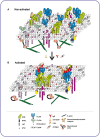Tetraspanins and Transmembrane Adaptor Proteins As Plasma Membrane Organizers-Mast Cell Case
- PMID: 27243007
- PMCID: PMC4861716
- DOI: 10.3389/fcell.2016.00043
Tetraspanins and Transmembrane Adaptor Proteins As Plasma Membrane Organizers-Mast Cell Case
Abstract
The plasma membrane contains diverse and specialized membrane domains, which include tetraspanin-enriched domains (TEMs) and transmembrane adaptor protein (TRAP)-enriched domains. Recent biophysical, microscopic, and functional studies indicated that TEMs and TRAP-enriched domains are involved in compartmentalization of physicochemical events of such important processes as immunoreceptor signal transduction and chemotaxis. Moreover, there is evidence of a cross-talk between TEMs and TRAP-enriched domains. In this review we discuss the presence and function of such domains and their crosstalk using mast cells as a model. The combined data based on analysis of selected mast cell-expressed tetraspanins [cluster of differentiation (CD)9, CD53, CD63, CD81, CD151)] or TRAPs [linker for activation of T cells (LAT), non-T cell activation linker (NTAL), and phosphoprotein associated with glycosphingolipid-enriched membrane microdomains (PAG)] using knockout mice or specific antibodies point to a diversity within these two families and bring evidence of the important roles of these molecules in signaling events. An example of this diversity is physical separation of two TRAPs, LAT and NTAL, which are in many aspects similar but show plasma membrane location in different microdomains in both non-activated and activated cells. Although our understanding of TEMs and TRAP-enriched domains is far from complete, pharmaceutical applications of the knowledge about these domains are under way.
Keywords: CD9; IgE receptor; LAT; NTAL; membrane microdomains; plasma membrane; signal transduction.
Figures


Similar articles
-
Cross-talk between tetraspanin CD9 and transmembrane adaptor protein non-T cell activation linker (NTAL) in mast cell activation and chemotaxis.J Biol Chem. 2013 Apr 5;288(14):9801-9814. doi: 10.1074/jbc.M112.449231. Epub 2013 Feb 26. J Biol Chem. 2013. PMID: 23443658 Free PMC article.
-
Transmembrane adaptor proteins in the high-affinity IgE receptor signaling.Front Immunol. 2012 Jan 11;2:95. doi: 10.3389/fimmu.2011.00095. eCollection 2011. Front Immunol. 2012. PMID: 22566884 Free PMC article.
-
Non-T cell activation linker (NTAL): a transmembrane adaptor protein involved in immunoreceptor signaling.J Exp Med. 2002 Dec 16;196(12):1617-26. doi: 10.1084/jem.20021405. J Exp Med. 2002. PMID: 12486104 Free PMC article.
-
Transmembrane adaptor proteins in membrane microdomains: important regulators of immunoreceptor signaling.Immunol Lett. 2004 Mar 29;92(1-2):43-9. doi: 10.1016/j.imlet.2003.10.013. Immunol Lett. 2004. PMID: 15081526 Review.
-
Control of lymphocyte development and activation by negative regulatory transmembrane adapter proteins.Immunol Rev. 2008 Aug;224:215-28. doi: 10.1111/j.1600-065X.2008.00656.x. Immunol Rev. 2008. PMID: 18759929 Review.
Cited by
-
Proteomic Analysis of Lipid Rafts from RBL-2H3 Mast Cells.Int J Mol Sci. 2019 Aug 11;20(16):3904. doi: 10.3390/ijms20163904. Int J Mol Sci. 2019. PMID: 31405203 Free PMC article.
-
Exosomal CD63 in critically ill patients with sepsis.Sci Rep. 2021 Oct 13;11(1):20300. doi: 10.1038/s41598-021-99777-w. Sci Rep. 2021. PMID: 34645935 Free PMC article.
-
Tetraspanins Function as Regulators of Cellular Signaling.Front Cell Dev Biol. 2017 Apr 6;5:34. doi: 10.3389/fcell.2017.00034. eCollection 2017. Front Cell Dev Biol. 2017. PMID: 28428953 Free PMC article. Review.
-
CD63 and C3AR1: The Potential Molecular Targets in the Progression of Septic Shock.Int J Gen Med. 2022 Jan 19;15:711-728. doi: 10.2147/IJGM.S338486. eCollection 2022. Int J Gen Med. 2022. PMID: 35082520 Free PMC article.
-
Arthropod EVs mediate dengue virus transmission through interaction with a tetraspanin domain containing glycoprotein Tsp29Fb.Proc Natl Acad Sci U S A. 2018 Jul 10;115(28):E6604-E6613. doi: 10.1073/pnas.1720125115. Epub 2018 Jun 26. Proc Natl Acad Sci U S A. 2018. PMID: 29946031 Free PMC article.
References
-
- Berditchevski F. (2001). Complexes of tetraspanins with integrins: more than meets the eye. J. Cell Sci. 114, 4143–4151. - PubMed
Publication types
LinkOut - more resources
Full Text Sources
Other Literature Sources
Research Materials
Miscellaneous

